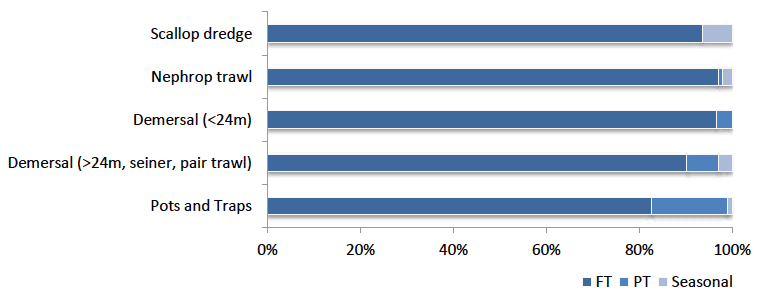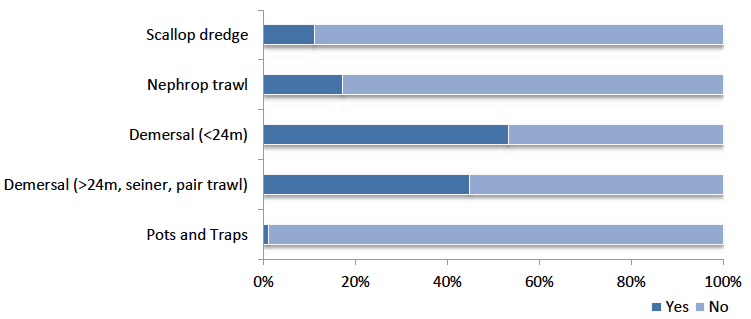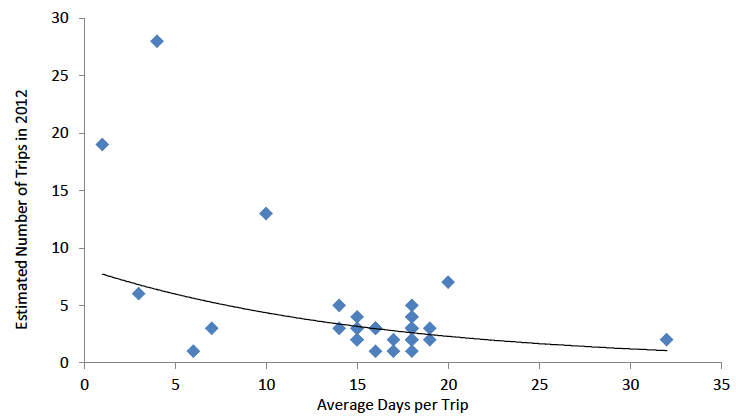Scottish Sea Fisheries Employment Report
This report details the findings of a new survey of crews on Scottish fishing vessels. It provides new information across a range of indicators such as age, nationality, job tenure and skills.
8. Work Patterns
The highest proportion of part time workers are in the pots and traps sector at 20% whilst part time were also present in the demersal (>24m, seiners and pair trawl) at 8% (Fig. 24). This would appear to be mainly owner/skippers who offer relief to the main skipper and holiday cover. This was also the case for demersal (<24m) vessel at a lower level (3%). Seasonal workers were most common on scallop dredgers at 7% and then demersal (>24m, seiner, and pair trawl) and Nephropss at 3% and 2% respectively.
Figure 24: Proportion of crew working full time ( FT) and part time ( PT) by key fishing sector

The information below is a combination of qualitative (descriptive) data given by crew across a range of boats on their average working day:
Pots and Traps: On average crews work a 10-12 hour day - up to 16 hours in the summer and down to 4-8 hours in winter. An average day consists of boat/engine maintenance, trip to potting grounds, 4-6 hours hauling and 1-2 hours baiting and sorting catch. Some vessels do not fish in winter or only if the weather is very good during these months. These vessels are day trips which are tide dependent for some, but most start at 6-7 am and return to harbour around 4-5 pm.
Demersal (>24m, seiners, pair trawl): Crew work, on average, a 12-16 hour day to a range of work patterns, the most common being 3 hours on with 2-3 hours off or 4 hours on with 2-4 hours off. Most vessels undertake 4 hauls a day of trawls ranging from 2.5 to 5 hours, with 1 hour required to haul and shoot. Most respondents said crew get a minimum of 6 hours off to rest and sleep in any 24 hour period.
Demersal (<24m): Similar patterns to demersal (>24m, seiners and pair trawl), with 2-4 hourly shift patterns and on average 4 hauls in a 24 hour period. An example from one crew who worked longer shift patterns was: up for morning shift at 2 am, work until 12 noon, sleep and lunch for 3-4 hours, work until 10 pm, sleep until 2 am. Another described an average day as 4 hauls per day each taking around 5 hours with 1 hour to haul and shoot and then 2.5-3 hours off during each haul.
Nephrops trawls: Crew work on average 12-15 hours for every 24 hours. Vessels in this sector range from day trips to 10 day trips. Like the demersal fleet most work shift patterns with 4 hours on and 2-4 hours off and undertake 3-4 hauls a day, each taking between 3-5 hours. Between hauls crew sort catch which takes about 1 hour per 60 kgs of Nephrops.
Scallop dredgers: Crew on scallop vessels work 10-16 hour days and in shift patterns with 2-4 hours on and 1-2 hours off. Boats average 10-14 dredges a day. Most vessels start at around 6 am and work until 11 pm.
Table 3: Working day/week per sector for fishing from reported min and max hours per days for comparison to a 40 hour weeks (20 days holiday and 10 days bank holiday).
| Average working hrs per day | Fishing days per year (2011)* | Equivalent hours per day | Average hours per week | |||||
|---|---|---|---|---|---|---|---|---|
| Min | Max | Min | Max | Min | Max | Mean | ||
| Pots and Traps | 8 | 12 | 178.4 | 6.2 | 9.3 | 31.0 | 46.5 | 38.7 |
| Demersal (>24m, seiner, pair trawl) | 12 | 16 | 184 | 9.6 | 12.8 | 48.0 | 64.0 | 56 |
| Demersal (<24m) | 12 | 16 | 167.7 | 8.7 | 11.7 | 43.7 | 58.3 | 51 |
| Nephrops trawl | 10 | 18 | 162.8 | 7.1 | 12.7 | 35.4 | 63.7 | 49.5 |
| Scallop dredge | 12 | 16 | 158.4 | 8.3 | 11.0 | 41.3 | 55.1 | 48.2 |
*Source: Seafish Annual Fleet Survey Scotland
Table 3 presents an estimate of working hours in each sector if days at sea were spread throughout the year and compared to a national average of 40 hours per week [5] . At mean working hours per week, all sectors excluding pots and traps work over 40 hours a week. For the two demersal sector this is 11 hours over a week and just under 10 hours extra for Nephrops and scallop dredges. If maximum hours are considered all sectors work more than a 40 hour week, ranging from 6.5 hours over for pots and traps up to 24 hours a week over for demersal (>24m, seiner, pair trawl).
Work outside of Fishing
All mobile sectors are active outside of fishing with over 50% of the vessels sampled in the demersal (<24m) fleet taking part in external work. This was slightly less for the demersal (>24m, seiner and pair trawl) at 45% with Nephrops and scallop vessels much lower at, 17% and 11% respectively (Fig. 25). All these vessels are working in guarding/oil and gas industry. Only 1 static vessel (pots and traps) said they worked outside of fishing, in aquaculture.
Figure 25: Proportion of vessels involved in other work outside of fishing

The average length of trips (days) for external work was plotted against the estimated number of trips undertaken in 2012. Figure 26 demonstrates that vessels undertaking longer trips conduct fewer trips overall. The majority of vessels are undertaking 1-5 trips a year which last for an average of 14-20 days as demonstrated by the clustering at the bottom of the graph. Some outliers show few very long trips (32 days) or many trips (28 trips) for relatively short periods.
Figure 26: Scatter plot of average number of days per trip with estimate number of trips in 2012

Contact
There is a problem
Thanks for your feedback